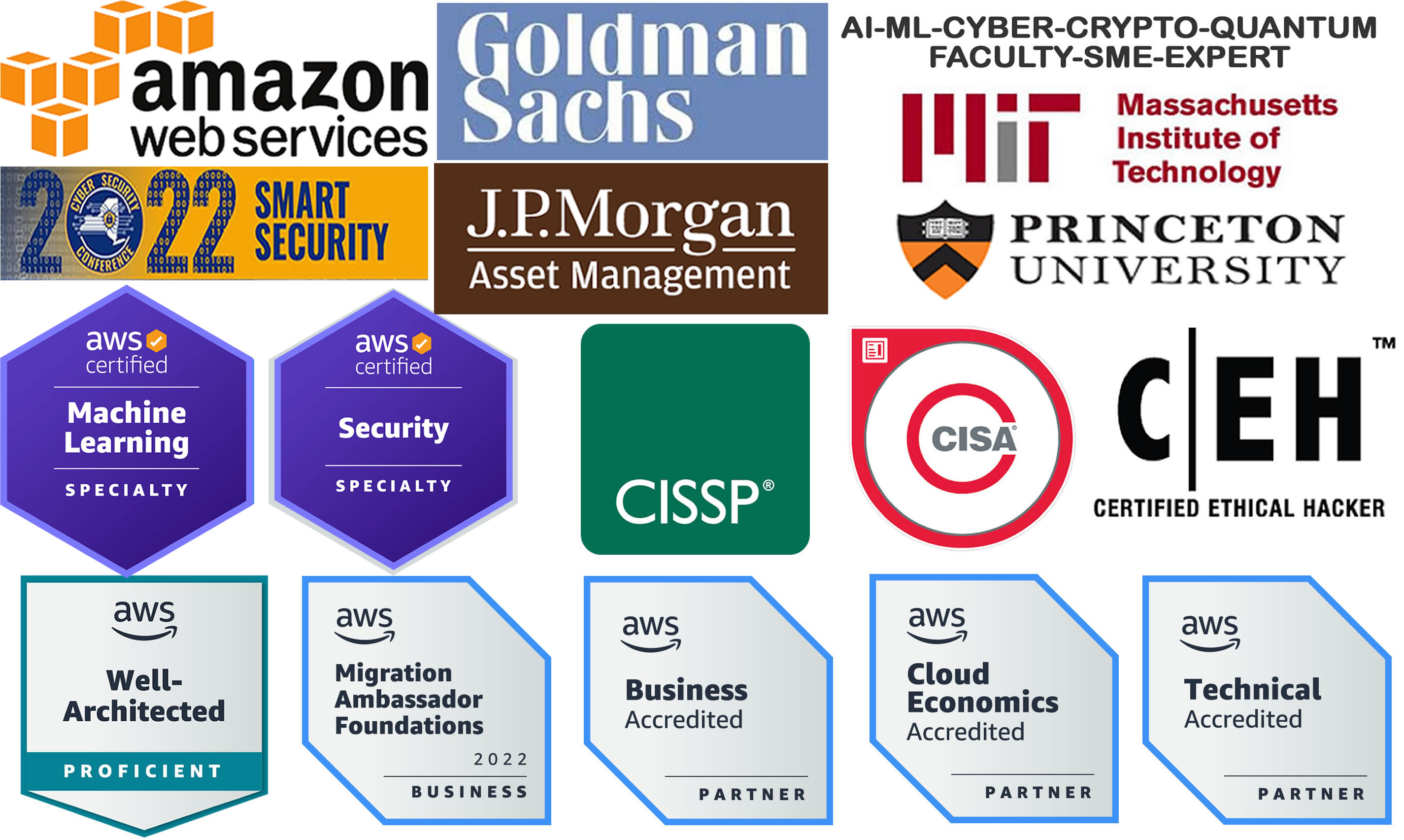Dr. Yogesh Malhotra: LinkedIn:
Wall Street Investment Banks Quant : MIT AI-Machine Learning Industry Expert : Princeton Quant FinTech Presentations:
[AI, Algorithms & Machine Learning] [Quantitative Analytics] [Cybersecurity Risk Engineering] [Digital Transformation] [Quant Finance & Trading] [Cyber Finance]
Who's Who in America®, Who's Who in the World®,
Who's Who in Finance & Industry®, Who's Who in Science & Engineering®
MIT: AI & Machine Learning: Industry Expert: MIT AI-Machine Learning Executive Guide including RPA & Cognitive Automation.
Princeton University: Invited Presentations: AI, Machine Learning, Deep Learning: Princeton Quant FinTech Presentations.
Ranked among Finance & IT Nobel Laureates in AACSB and Scientific Impact Studies for Real World Impact of Research.
Global Financial Regulation (Interview: Hong Kong Institute of CPAs)
Download the PDF research report titled:
Bitcoin Protocol: Model of ‘Cryptographic Proof’ Based
Global Crypto-Currency & Electronic Payments System
| Future of Bitcoin & Statistical Probabilistic Quantitative Methods: Global Financial Regulation (Interview: Hong Kong Institute of CPAs) |
||
| Yogesh Malhotra, PhD
Global Risk Management Network, LLC
"The much-vaunted security of [Bitcoin's] underlying protocol has also been questioned. “Several risks, threats, and vulnerabilities are inherent in the design of the bitcoin protocol which is susceptible to cryptographic vulnerabilities,” says Yogesh Malhotra, Chief Research Scientist at Global Risk Management Network..." - Hong Kong Institute of Certified Public Accountants Magazine, A+, 10(2), February 2014. "Tokyo-based bitcoin exchange Mt. Gox filed for bankruptcy last week, saying hackers had stolen the equivalent of $460 million from its online coffers. The news rocked the bitcoin world, and it could even bring down the much-hyped digital currency."
Interviewer: George W. Russell for the Hong Kong Institute of Certified Public Accountants. "Recently, such probabilistic, statistical, and numerical methods related concerns are in globally popular press related to cybersecurity controls and compliance. Earlier, similar probabilistic, statistical, and numerical methods related concerns were in the global popular press in the context of the global financial crisis. Future questions focused on the underlying assumptions and logic may focus on related implications for compliance, controls, valuation, risk management, etc. Likewise, recent developments about mathematical entropy measures shedding new light on apparently greater vulnerability of prior encryption mechanisms may offer additional insights for compliance and control experts. For instance, given related mathematical, statistical and numerical frameworks, analysis may also focus on potential implications for pricing, valuation and risk models. The important point is that many such fundamental assumptions and logic underlying widely used probabilistic, statistical, and numerical methods may not as readily meet the eye." How do you see bitcoin's future? There are two aspects to bitcoin’s future. First relates to the cryptographic ‘bitcoin protocol’ and the second relates to the crypto-currency ‘bitcoin coin’ or BTC. Crypto-currency BTC seems to get most media coverage given its role in global monetary transactions, electronic payments and related governmental and regulatory concerns. However, its underlying ‘bitcoin protocol’ based upon cryptographic proof-of-work is what is often attributed for related innovations. Some such innovations of the cryptographic protocol enable creation and regulation of issue of the crypto-currency BTC, preventing its counterfeiting and double-spending, and securing its global transmission at minimal transaction cost and processing time. World governments and global financial institutions such as big banks are interested in the technical protocol and related cryptographic frameworks and technologies. Given their interest in developing and controlling such crypto-currencies, global governments and financial institutions represent potential competitive threats to BTC and other crypto-currencies. For example, while Canadian Government has declared that BTC digital ‘currency’ is not legal tender in the country, the Royal Canadian Mint has unveiled the prototype of the MintChip – digital currency similar to BTC but backed by the Canadian dollar and paired with a credit and debit machine. Being pegged to the Canadian dollar is expected to avert the kind of risky speculative spikes and drops typically associated with BTC and related volatility concerns of regulators such as in China. Hence, in the financial, monetary, and regulatory contexts, the ‘bitcoin protocol’ based upon cryptographic proof-of-work seems to have a greater shelf life than crypto-currencies such as BTC. The technical protocol not only underlies BTC but other competing crypto-currencies with some notable differences. Its features such as P2P network based decentralization without need of a third-party intermediary underlie future digital innovations enabled by public key cryptography such as next-generation electronic contracting as well as next-generation social networks. My research report on Bitcoin Protocol with focus on BTC mining, transactions, and payments explaining the above contrast between the protocol and the currency is accessible at http://yogeshmalhotra.com/BitcoinProtocol.html. BTC and other crypto-currencies seem to embody the digital evolution of money from what we think of as ‘real money’ to ‘quantum money’. The underlying technical cryptographic protocol is what seems to hold most appeal in terms of such future innovations to national and state governments, regulators, financial institutions, and private enterprises including those enabling the current crypto-currencies as well as other players. How do you see bitcoin's future in China?Bitcoin’s future in China and Hong Kong should probably not be much different from its future in other nations across the world if current commonly shared governmental and regulatory trends continue. Current key concerns of government and financial regulators in China mirror those of other nations such as Hong Kong, Taiwan, Canada and the USA. China’s central bank expressed concerns about BTC that more or less mirror other nations’ such as US central bank’s concerns including lack of legal status, high risks of money laundering, and potential association with illegal activities. Bypassing traditional financial intermediaries such as banks, BTC transactions via decentralized P2P network enable movement of large amounts of currencies cheaply, almost instantly, and potentially anonymously. As noted in the above Bitcoin Protocol research report, China earlier allowed popular participation in bitcoin market while emphasizing just like most other countries that it does not recognize BTC. Given highly speculative trend of BTC traders, China’s prior stance was associated with BTC jumping past the $1,000 mark for the first time and BTC China taking over Mt. Gox as the world’s largest BTC exchange. A report noted large scale money flows out of China illegally, with Chinese share of US residential real estate jumping 50% last year with total Chinese ownership of $450 billion to $700 billion in offshore assets. Another analyst noted yuan-BTC exchange rate becoming the leading indicator of the USD-BTC rate. Like most other governments, China seems concerned about its control of monetary policy, cross-border currency and capital flows, and currency exchange rates. In addition to prior concerns noted above, such policy concerns mirroring concerns expressed by other nations, motivated China to subsequently ban financial institutions and payment companies from handling virtual currencies. BTC China and other exchanges are trying to work around the ban while trying to reduce highly speculative price volatility of the BTC. BTC China had earlier removed its trading fees resulting in a surge in trading volumes resulting in record high BTC price of $1,214 on Dec. 1. Recently, to reduce speculative trading, it reintroduced the trading fees. Just last week, BTC China reported that trading volumes are being gradually restored by use of vouchers that bypass third-party payment providers and referral incentives. The Chinese government has turned against bitcoin in the regulatory environment. How does that affect the bitcoin market? Like most other nations, given China’s apparently cautious stance about widespread unregulated and uncontrolled use of virtual currencies, it should not be surprising if BTC’s future tracks similarly across most countries. Europe was the first to recognize the potential risk of losing control of monetary policy with current trend of cautiously watching developments while watching over the interests of consumers. Mirroring the above concerns, China’s largest online marketplace, Alibaba group, banned sale of BTCs “in the interest of consumer protection” and to better manage its internal controls on capital flows given its planned IPO later this year. Like other concerned nations, China’s central bank banned financial institutions from BTC trading expressing that the government would act to prevent associated money laundering risks. China did not first ban individual trading of BTCs subsequently asking third-party payment services to stop BTC transactions forcing exchanges such as BTC China to stop taking Chinese yuan deposits. However, caution on part of China and other nations is one of many other factors noted below that affect the BTC market besides inherent risks and vulnerabilities in the bitcoin protocol and the global arms race of monopolistic and oligopolistic mining pools and botnets that can subvert control of the P2P BTC networks. Volatility related to spikes in BTC price also results from announcements such as the one by the largest social-network gaming sites announcing acceptance of BTC. Ironically, some such prominent social-network gaming sites are already targets of ongoing surveillance and investigations by various national government agencies searching for terrorist and criminal networks. Several risks, threats, and vulnerabilities are inherent in the design of the bitcoin protocol which is susceptible to cryptographic vulnerabilities and threats as noted in my Bitcoin Protocol research report. For example, a specific attack on BTC P2P network results from anyone in the network acquiring predominant (>50%) computing power being able to exclude, modify, and self-reverse transactions and prevent some or all mining of valid blocks of BTC transactions. Even with less than 50% power such attacks are feasible: e.g. someone with 40% of network computing power can overcome a 6-deep confirmed transaction with a 50% success rate. In the beginning of the second week of January, 2014, a mining pool GHash.io run by a Ukraine-based secretive company CEX.io is reported to have controlled 45% of BTC network computing power by eliminating BTC trading fees. Such dominance allows it to reverse transactions and makes its ‘double spending’ of existing BTCs feasible rendering the integrity of the BTC network suspect and crypto-currency effectively unusable by others. Even though CEX.io issued a press release about reducing such dominance, however nothing stops it or others such as China and Hong Kong based entrepreneurs from launching such attacks individually or as oligopolies. The latest developments have led a Bloomberg report to conclude that bitcoin is now less a currency than a kind of risky bond for which the issuers bear no responsibility, hence investors should be aware that the situation is ripe for abuse. Related risks obviously motivated recent policy decisions of various governments and regulators such as in China and Hong Kong. More details about ‘double spending’ and other related bitcoin attacks, threats, and vulnerabilities are available in the Bitcoin Protocol report. There are plans to install a bitcoin-ready ATM in Hong Kong - what effect will this have? Quite likely, installation of a bitcoin-ready ATM in Hong Kong will have no significant effect based upon current state of global regulatory announcements about BTC. The likely effect of BTC-ATMs being installed in Hong Kong or in any other city may be deduced from three angles. First, even though such trend has existed only over a short term, one may try to generalize based on what effect BTC-ATMs had in other cities in other countries such as Canada that have been in BTC regulation related headlines. Second, despite differences across national monetary, capital, and currency control policies, overall similar and shared policy concerns guiding recent BTC regulations and enforcements may help to deduce such effects in predicting the future of BTC. Third, specific analysis and observations reported by regulators of China, Hong Kong, Taiwan and other countries such as Canada and USA have noted no significant effect of BTCs on their respective financial systems. The last point is self-evident given current 12 million BTCs in circulation with total circulation capped at 21 million by 2140: representing a very small fraction relative to national and global financial money supplies and transaction volumes. The first two points are further explained below with specific evidence already on public record. First Point: Installation of a BTC-ATM seems to have virtually no effect, i.e., it is an imprecise predictor, if it can be considered a predictor at all, of related national or state regulatory or monitory policy. Installation of a BTC-ATM merely demonstrates if current laws exist to out-rightly ban installation of BTC-ATMs or not. It doesn’t predict if subsequently, BTC or even BTC ATMs will be outlawed or banned or not. Hence, regardless of installation of BTC-ATMs, the future of BTCs will depend upon the individual national and state regulatory policy and related enforcement as further explained below. Evidence: World’s first ATM was reportedly installed in Vancouver, Canada, in October last year. However, subsequently Canada’s Big-6 banks froze or shut down accounts of BTC exchanges; Canadian central bank is offering digital alternative to BTC; and Canadian government declared that BTC is not legal tender in country. Thereafter, Toronto and Ottawa also reported recent installations of BTC ATMs. There is a rumor about a local entrepreneur planning installation of New York City’s first ATM in the USA; however, New York City is in the process of creating a regulatory framework for BTC and other alternative crypto-currencies. 22 BTC-related companies are reported to have been subpoenaed by the New York City Department of Financial Services for public hearings starting in the last week of January, 2014. Some popular media reports seem to perhaps imprecisely quote the comments from the letter of US Fed chief that he attributed to others in his letter filed in the context of the US Senate hearings of November, 2013. The source letter is accessible from the Bitcoin Protocol report which provides a more balanced summary of the Fed chairman’s comments besides noting comments that he attributed to other sources. Diverse popular media reports seem to also offer contrasting account of the above US Senate hearings ranging in terms such as a ‘BTC lovefest’ and a ‘BTC hot potato’ event. The facts evident from the US Fed chief’s letter establish that he in fact noted that virtual currency exchanges and related bank transactions must comply with Bank Secrecy Act (BSA) and Anti-Money Laundering (AML) requirements. Also, he reinforced Fed’s role in the enforcement of the US Patriot Act against Bitcoin exchanges such as the Liberty Reserve S.A. which was held guilty in a $6 billion money-laundering case. Second Point: Despite some contrasts across national policies described in popular media reports, the primary concerns of governments and regulators across nations including China and Hong Kong actually seem quite consistent. Hence, despite any superficial differences that sometimes seem to be exaggerated in some media reports, most major nations seem to share consistent and common regulatory concerns about BTCs. Accordingly, if the current trend continues, the future of national regulatory policies and enforcements may probably have similar impact on the future of BTC. Evidence: Recent ruling of the Canadian government that BTC is not legal tender is further amplified by one of Canada’s Big-6 banks which notes: “Smaller, stand-alone payment systems for which there are many substitutes – like bitcoin — should generally require much less intensive oversight and regulation because they pose much less risk to the Canadian financial system as a whole.” Following statement by the same bank sums up the concerns about BTC. “Nevertheless, these payment systems should be designed and operated to meet the needs of Canadians which would include convenience and ease of use, price, reliability, safety, and effective redress mechanisms.” BTC currently does not offer stability of price given extreme volatility; questions about reliability and safety have led to accounts of BTC exchanges being frozen by banks; and, consumers have no redress even for goods or services that they do not receive even after making BTC payments given nonrepudiation related inadequacies. Similar sentiment is shared by financial regulators and institutions, whether in Hong Kong, China, or Taiwan, or for that matter in most other countries. Probably none of them will disagree with the above ‘core’ concerns about safeguarding the financial interests of their citizens. Hong Kong Monetary Authority (HKMA) noted “It appears the proposed machine is another channel for acquiring Bitcoin or a vending machine. Bitcoin is not regulated by the HKMA. Bitcoin is not a currency, but a virtual commodity.” In contrast, Taiwanese Financial Supervisory Commission (FSC) observed that “Bitcoin is not a currency. Financial institutions and the public shouldn't use it as medium of payment. Given Bitcoin's non-currency status, no bank deposits should be made with it, and banks are not allowed to receive or provide Bitcoins. To install Bitcoin ATMs would require approval from FSC, which will not be given, so it is impossible for a Bitcoin ATM to come to or appear in Taiwan.” The People's Bank of China last month outlawed Bitcoin transactions among local banks and financial institutions, forbidding all third-party payment providers from handling the BTC crypto-currency. The country's central bank had expressed concerns about Bitcoin's lack of legal status, high risks of money laundering, and potential association with illegal activities. Similarly, reports painting an apparent contrast between Hong Kong and Taiwan with the former getting its first ATM must be very carefully interpreted. While no regulatory approval is required from the Hong Kong Monetary Authority (HKMA) to set up a BTC ATM in Hong Kong as HKMA considers it a vending machine, installation of BTC ATM in Taiwan requires regulatory approval from the Taiwanese Financial Supervisory Commission (FSC). Such concerns are more or less similar to those expressed by most national regulators in USA, Asia, Europe, or elsewhere. How can accountants make provisions for bitcoin-denominated transactions in financial reports etc. As apparent, accountants will need to follow regulatory guidelines such as Generally Accepted Accounting Standards (GAAP), International Financial Reporting Standards (IFRS), and Hong Kong Financial Reporting Standards (HKFRS). However, they need to be cognizant about the legal status and legal classification being accorded to BTC by the specific governments and regulators such as in terms of ‘legal tender’ which is different from ‘virtual currency’ as well as ‘virtual commodity.’ Most nations including China, Hong Kong, and Taiwan as well as others such as US, Canada and Germany have specifically and explicitly ruled that BTC is not ‘legal tender’, it is not backed by any government or any other legal entity, and its supply is not determined by a government central bank. A government central bank issued currency is legal tender in the sense that it is acceptable and legally used for settlement of debts and payment of taxes. In contrast, creditors are not required by law to settle debts in lieu of BTC payments. Nor do governments accept BTCs for tax payments. Hence, it is important to note that even though terms such as virtual currency, digital currency, and crypto-currency are loosely used to describe BTC, however it doesn’t enjoy the same status as government central bank issued currencies such as the Chinese yuan, the Hong Kong dollar, the US dollar, or even Royal Canadian Mint’s digital currency MintChip which is backed by the Government of Canada. BTC and other non-government virtual currencies are deemed highly speculative and risky for consumers as their value is not backed by any physical commodity such as gold, issuers such as central banks, or the real economy. Consistently, wherever existing regulatory laws and policies require ATMs (automated teller machines) to dispense currencies, coins, and bills that are ‘legal tender’, i.e., issued and backed by government central banks, BTC ATMs will not be allowed by law. Taiwan represents such an illustrative case. Even though China, Hong Kong, and Taiwan have accorded the same legal status to BTC as ‘virtual commodity’, statements of their national regulators’ seem to have been superficially interpreted in some media reports as contrasts in respective legal status accorded to BTC which is not the case. Hence, it is important to distinguish the issue of BTC acceptance as ‘legal tender’ from the stance of Hong Kong Monetary Authority (HKMA) about not regulating ‘virtual commodities.’ Given that they do not consider BTC legal tender just like all other governments, what HKMA has simply noted is that they really don’t regulate installation of ‘vending machines’ that dispense commodities such as BTCs, Dutch tulips, dolphin teeth, or chewing gum. Dutch tulips are known for the speculative economic bubble known as tulip mania wherein mere ‘scarcity’ of tulip bulbs was somehow foolishly interpreted as their ‘intrinsic value.’ Dolphin teeth have enjoyed the role of private money currency among the people of Solomon Islands. In mid-January of 2014 HKMA’s point was made amply clear a week after the announcement of BTC ATM deployment in Hong Kong by private entrepreneurs when HKMA specifically rejected the description of BTC as a ‘virtual currency’ underscoring that BTC fails to meet ‘the two preconditions of a virtual currency: consensus on its par value and confidence in the issuers.’ That being said, it is important to recognize why many governments, among China, Hong Kong, US, and Germany are interested in characterizing BTC as a ‘virtual commodity’ or ‘private money’ but not legal tender. Specific classifications of BTC transactions and investments and related nuances can then be applied for interpreting and applying the specific GAAP, IFRS and HKFRS standards in financial accounting and auditing statements. Particularly, being aware about the specific evolving regulatory guidelines will enable accountants and auditors in Hong Kong and elsewhere to make provisions for compliance about BTC-related disclosure and reporting. Specific reasons that are motivating most governments’ classification of legal status of BTC include controlling money laundering and investment frauds, and, imposing and collecting sales taxes and capital gains taxes resulting from BTC transactions and BTC investments. The Notice on Precautions Against the Risks of Bitcoins, issued on December 5 by People's Bank of China among other mainland ministry/commissions emphasized that BTCs have no legal status equivalent to that of a currency. That Notice expressly required all financial institutions and payment institutions not to embark on any BTC-related services such as provision payment, clearing and settlement for transactions. In the same week, Central Bank of China had observed that “Bitcoin is a certain virtual commodity, does not possess the same legal status as currency and cannot and should not be circulated and used in the market as such” adding that “ordinary people, under the premise of voluntarily shouldering the risk, have the freedom to participate in bitcoin trading as a kind of buying and selling activity on the Internet.” In the same week, the Central Bank of Taiwan emulating the Central Bank of China specified status of BTC as not being a currency in the real sense [i.e., legal tender] but a virtual commodity with general public being free to participate in its trading while shouldering all associated risks. Earlier, on November 20th, 2013, the Central Bank of Taiwan declared BTC as a ‘new kind of money circulating among a specific group of people.’ In the last week of 2013, Central Bank of Taiwan noted that “Bitcoin holders are on their own, as the currency is not issued by any monetary authority and is therefore not entitled to legal claims or guarantee of conversion.” On January 8, 2014, Hong Kong Government issued its directive that virtual currencies such as BTC are virtual commodities which given their price volatility and lack of price stability are difficult to foresee as becoming common medium of payment or e-currency. In mid-January of 2014, the US senator who held the first congressional hearing about bitcoin on November 18, 2013, had asked the US Commodity Futures Trading Commission (CFTC) to clarify how it will regulate BTC. The outgoing CFTC chairman noted: “While the commission does not have policies and procedures that are specific to virtual currencies, the agency’s regulatory authority extends to futures and swaps contracts in any commodity,” observing that the law “broadly defines the term commodity,” but didn’t lay out any plan to regulate virtual currencies or approve products based on them, however the agency has “broad enforcement powers” on commodities. In August, 2013, the German Finance Ministry had noted that BTC is not e-money or foreign currency, but ‘private money’ that can be used in ‘multilateral clearing circles.’ A member of the German parliament’s Finance committee responsible for legal classification of BTCs had noted that German authorities were preparing regulations on how to tax bitcoin transactions. In other words, the legal classification of BTC meant that commercial profits resulting from using BTCs in trade may be taxable. In the first week of January, 2014, the German Central Bank alerted that BTCs were “highly speculative” due to their high volatility and the way they were constructed, and noted that “There is no state guarantee for Bitcoins and investors could lose all their money. The Bundesbank is warning emphatically about these risks.” A month earlier, the European Banking Authority had warned that consumers were not protected by any refund rights under EU law when using virtual currencies such as BTCs for commercial transactions. As noted, most governments are classifying legal status of BTC to control money laundering and investment frauds, and, impose and collect sales and capital gains taxes from BTC related activities. Hong Kong Government’s 2014 directive noted that even though like many other regions, Hong Kong at present has no legislation directly regulating bitcoins and other similar virtual currencies, however, their existing laws such as the Organised and Serious Crimes Ordinance provided sanctions against unlawful acts involving bitcoins, such as fraud or money laundering. In the first week of December, 2014, Central Bank of Taiwan issued a directive for BTC trading Web sites to register in compliance with Telecommunications Act and the Regulation on Internet Information Service and relevant organizations to follow the requirements of the Anti-Money Laundering Act in compliance with the legally required anti-money laundering procedures such as KYC and suspicious transaction reporting. In the first week of January, 2014, Hong Kong’s Secretary for Financial Services and the Treasury warned the public that BTC is a highly speculative commodity which poses numerous risks consistent with what Taiwan had said earlier while denying license for operating BTC-ATMs in the country. In the second week of January, 2014, Hong Kong Monetary Authority (HKMA) warned regulated banks to monitor potential and existing customers dealing in or operating schemes related to virtual currencies such as BTC particularly given money-laundering risks associated with the relative anonymity afforded by BTC transactions. Noting that ‘virtual commodities’ transacted or held anonymously pose significantly higher money laundering and terrorist financing risks, HKMA further reinforced banks compliance responsibilities under its Anti-Money Laundering and Counter-Terrorist Financing (Financial Institutions) Ordinance (AMLO) of April 2012. Virtual currencies related AML risks were earlier highlighted in May, 2013, when the U.S. government closed Liberty Reserve, a BTC exchange, and arrested its founders on money laundering charges. Since then Internal Revenue Service (IRS) had also begun investigations into the potential use of digital currencies for tax evasion, a criminal activity representing a predicate offence for money laundering in several regions including Hong Kong. US Fed chief’s letter of September 6, 2013 in context of the November 18, 2013, U.S. Senate Committee on Homeland Security & Governmental Affairs had earlier observed that such virtual currency exchanges and related bank transactions must comply with Bank Secrecy Act (BSA) and Anti-Money Laundering (AML) requirements. He also reinforced Fed’s role in enforcement of section 311 of US Patriot Act against Bitcoin exchanges such as Liberty Reserve S.A. which pleaded guilty in a $6 billion money-laundering case. US statute applicable to ‘financial transactions’ doesn’t directly apply to AML in case of BTC as such transactions must involve ‘monetary instrument’ including ‘coin or currency of the United States or of any other country’. BTC is not legal tender given it is not issued by any national government or central bank. AML statutes however also apply to financial institutions that are in the money services business. Hence BTC exchanges and miners engaged in sale or trading of BTCs were notified in their role as money service businesses in March last year by US Treasury’s Financial Crimes Enforcement Network to report BTC transactions and identities. Likewise, definition of securities that include investment contracts involving taking money from customers to generate profits qualifies as a security under the SEC regulations and is thus covered by related AML regulations. Future delivery of option or futures subject to CFTC regulations is similarly applicable to future delivery of BTCs. Everyone paid in BTCs is subject to US federal tax law applying to all income from whatever sources. Laws about capital assets generating capital gains can also be extended to miners and investors of BTCs. Based upon the above observations, two key conclusions can be drawn at the moment that seem relevant to disclosure and reporting by accountants and auditors in China, Hong Kong, Taiwan, Canada, USA and elsewhere. First, regulators across most nations including China and Hong Kong in Asia and Canada and USA in North America are actively monitoring BTC developments while in the process of formulating specific regulations related to BTC and other virtual currencies. Second, most legal entities seem to be following similar regulatory strategies based on existing regional, national, state, and agency frameworks while in process evolving frameworks to address shared concerns such as those related to money laundering and terrorist financing, investment frauds, sales taxes, and capital gains taxes. Generally, how can accountants best acquaint themselves with the bitcoin environment? As apparent, the recent developments in the bitcoin environment represent a microcosm of the evolving state of global financial and accounting regulation with increasingly information-intensive virtual global financial currencies, financial instruments, and financial exchanges. Years ago, as a management consultant and software engineer with a global French bank in Hong Kong I was designing and developing Hong Kong Government’s Treasury Management System with focus on multi-currency arbitrage. On returning to the USA, I found discussions with accountants here who were caught up in what seemed soon to be traditional notions of ‘intangibles’ accounting at the time of emergence of the World Wide Web quite insightful. Subsequently, I have had the privilege of being invited by the United Nations Headquarters to advise their global constituencies on the national asset measurements related to digital and virtual knowledge assets. From similar experiences, there are two apparent lessons learned that may be relevant for accountants to acquaint themselves with the increasingly virtual global environments of financial currencies and instruments including BTC and other crypto-currencies. The first lesson learned is common with Apple CEO Steve Job’s playbook that he shared in 2007: “There’s an old Wayne Gretzky quote that I love. ‘I skate to where the puck is going to be, not where it has been.’” (Wayne Douglas Gretzky is a Canadian former professional ice hockey player called "the greatest hockey player ever." A puck is a disk made of vulcanized rubber used in professional ice hockey serving the same function as a ball.) Given evolving state of global information and technology developments currently morphing national and global financial systems to increasingly virtual forms, accountants, auditors, and regulators will need to develop related foresights. For instance, if today we need to understand crypto-currencies such as BTC, tomorrow may be about quantum money given that money and related global transaction and payment systems and mechanisms will continue to evolve. While some may speculate quantitative computing applications becoming mainstream in next three to ten years, history, as in the case of RSA, however shows that in some cases speculated future may arrive much, much sooner than speculated by even the smartest scientists at the most prestigious institutions. The second lesson learned relates to what all of us who are professionally trained as accountants and auditors are taught: that of professional skepticism. All of us know that professional skepticism of the accountant and auditor is most critical to ensuring an attitude based upon a questioning mind and a critical assessment of evidence. In formal quantitative research methods, the process is sometimes called triangulation of observations using diverse research methods and measures. Additionally, it may involve analyzing the fundamental assumptions and logic underling any crypto-system, financial instrument, or a narrative legal or policy argument or directive, for example. It is likely that model risks encountered in global financial systems and risk management systems such as those assessed using VaR (Value at Risk) and other quantitative finance frameworks could have been better served by a similar attitude. Similarly, in a different context such as in the case of cybersecurity controls and compliance, having analyzed the security of an encryption system, it may be equally important to ensure the robustness of the underlying random number generator and other algorithms. Going forward, one may observe that similar random number generators are also extensively used as predictive stochastic determinants of future prices of financial instruments as in Monte Carlo models. Recently, such probabilistic, statistical, and numerical methods related concerns are in globally popular press related to cybersecurity controls and compliance. Earlier, similar probabilistic, statistical, and numerical methods related concerns were in the global popular press in the context of the global financial crisis. Future questions focused on the underlying assumptions and logic may focus on related implications for compliance, controls, valuation, risk management, etc. Likewise, recent developments about mathematical entropy measures shedding new light on apparently greater vulnerability of prior encryption mechanisms may offer additional insights for compliance and control experts. For instance, given related mathematical, statistical and numerical frameworks, analysis may also focus on potential implications for pricing, valuation and risk models. The important point is that many such fundamental assumptions and logic underlying widely used probabilistic, statistical, and numerical methods may not as readily meet the eye. For instance, most accountants and analysts may take the random number generators used in modeling for granted. However, sophistication and finesse of any modeling and analysis is only as good as the underlying foundations such as those discussed above. Above illustrative examples relate to one or more of the CPA accountant and auditor practice areas, such as financial valuations, pricing, forensics, and taxation as well as related controls and compliance. However, the above two lessons learned can probably apply equally to other related practice areas. |
























































